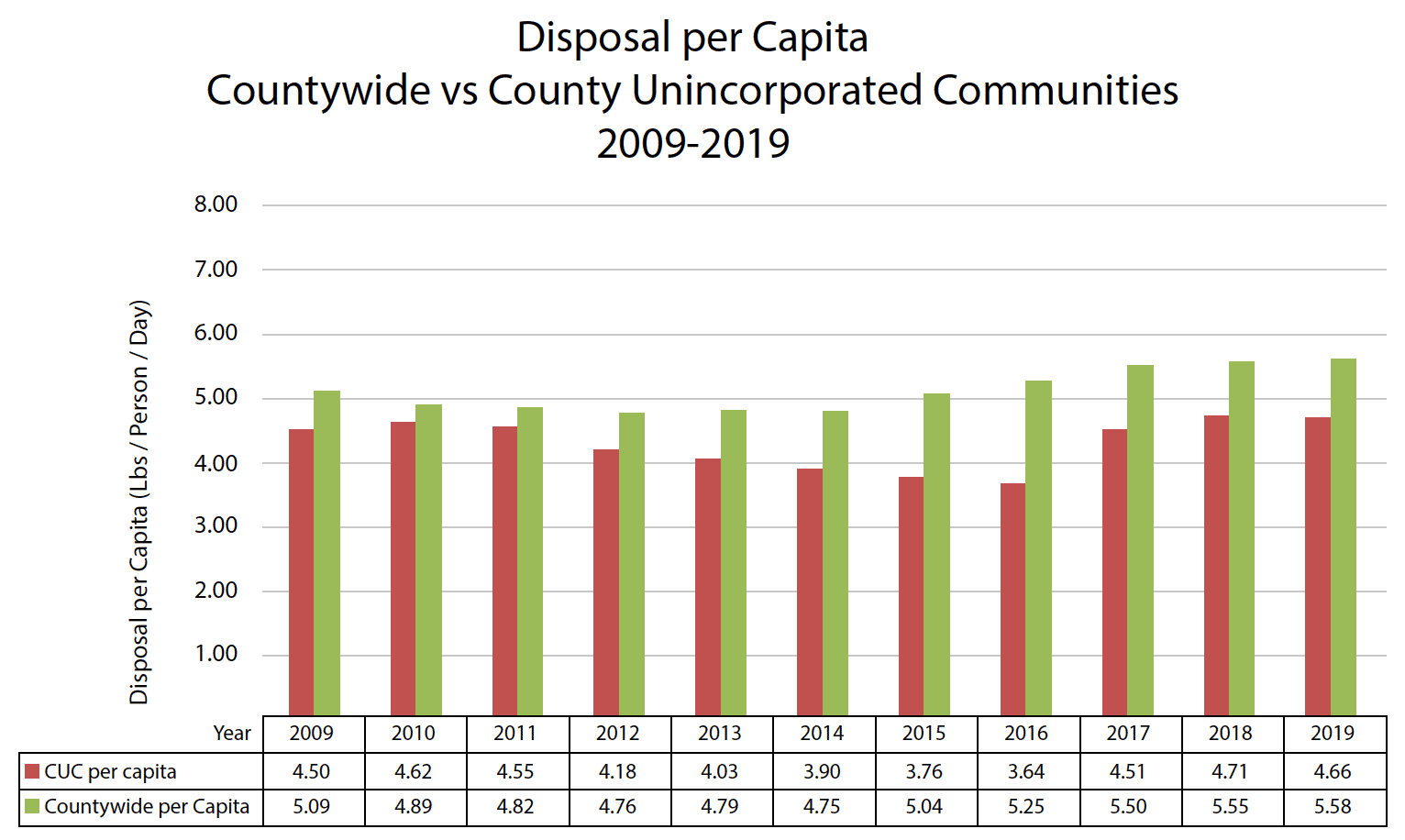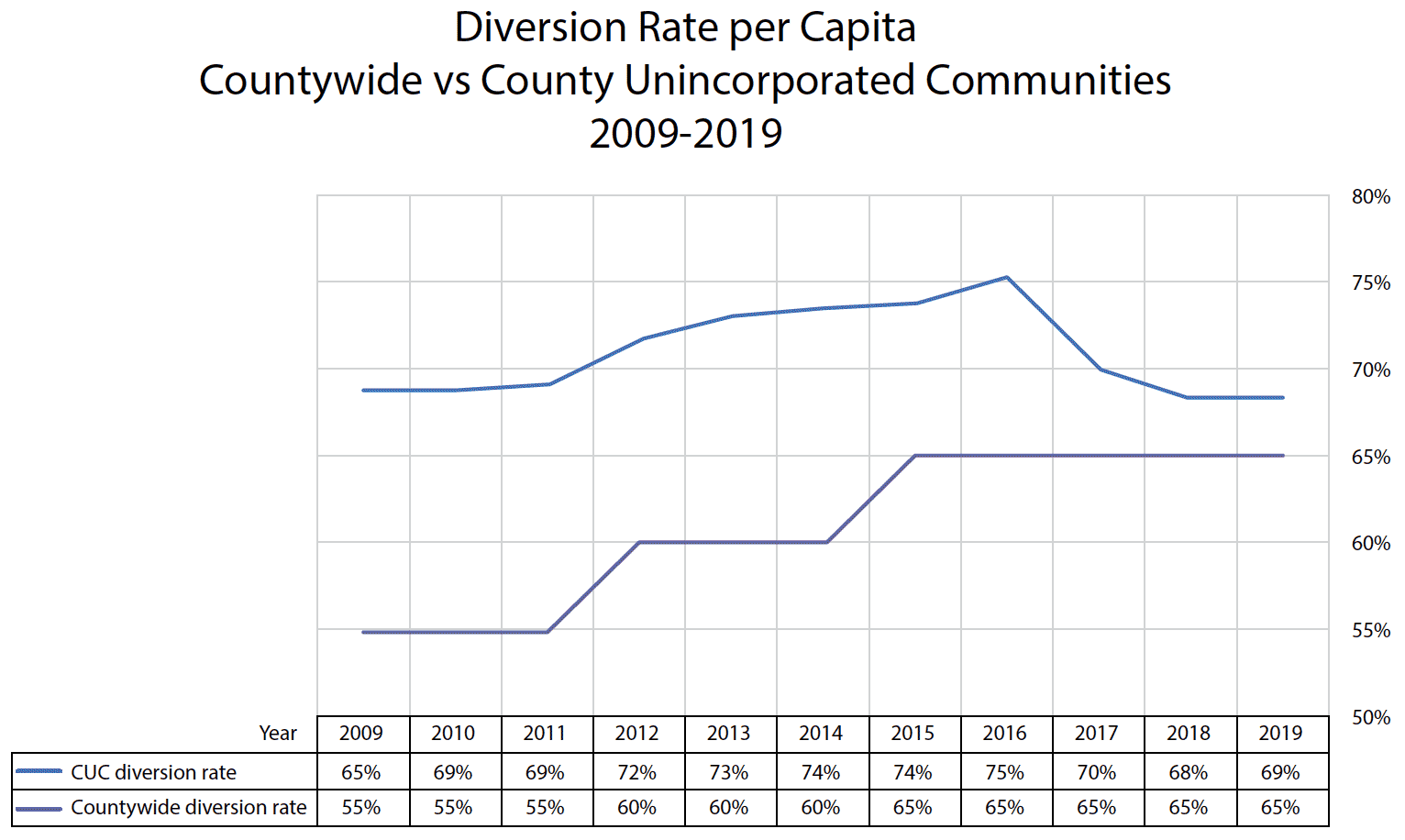Welcome to Los Angeles County
Zero Waste Plan
A ROADMAP TO GREENER AND MORE SUSTAINABLE COMMUNITIES
Los Angeles County is seeking to establish a sustainable waste management system by shifting to a circular economy and reducing reliance on limited landfill capacity for disposal of solid waste. The purpose of the Los Angeles County Zero Waste Plan is to lay out the general framework for the strategies and initiatives that the County can implement to decrease reliance on landfills by promoting source reduction and reuse, as well as maximizing the recovery of products, materials, and energy from waste that would otherwise be disposed at landfills.

Background
Managing solid waste in a sustainable manner is very important to protect public health and the environment. There is limited capacity in landfills for disposal, so it is crucial that we reduce the amount of waste we generate.
Waste breaks down in landfills and creates harmful greenhouse gases such as methane and carbon dioxide. It is very important that we reuse and recover materials and products to the maximum extent possible to save natural resources and combat climate change.
In 2014, the County adopted the original Roadmap to a Sustainable Waste Management Future (Roadmap), which established the goals of 80 percent waste diversion from landfill disposal by 2025, 90 percent waste diversion by 2035, and 95+ percent waste diversion by 2045. The Roadmap laid out the general framework for implementing strategies to meet these goals.
Since the adoption of the Roadmap, there have major changes impacting recycling markets and waste management. These changes include, China’s National Sword Policy, which banned importing certain materials and established a very stringent contamination standard (0.05 percent) that requires upgraded processing infrastructure and effort to achieve. In addition, new organic waste management laws established statewide targets to reduce organic waste landfill disposal 50 percent by 2020 and 75 percent by 2025.
These new challenges guided the County to update the Roadmap and rename it the Los Angeles County Zero Waste Plan. The Zero Waste Plan identifies the programs and policies needed to achieve ambitious zero waste targets and shift away from a reliance on limited landfill capacity for disposal of solid waste.


Alignment with Current County Priorities
The strategies identified in the Zero Waste Plan align closely with Los Angeles County’s adopted plans and priorities, as well as other sustainability efforts, including the following:
Los Angeles County Countywide Siting Element (CSE) – The Los Angeles County CSE assesses the disposal needs of the 88 cities and the CUCs for a 15-year planning period. CSE plans are prepared in compliance with the California Integrated Waste Management Act of 1989 (AB 939). AB 939 requires cities and counties to divert 25 percent of their solid waste from landfills and solid waste facilities by 1995 and 50 percent by the year 2000, and every year thereafter, through source reduction, recycling, and composting programs.
Los Angeles County Strategic Plan (2016-2021) – This plan provides direction to departments and their partners to ensure their efforts are aligned with Board priorities. The plan is broken down into three goals, with the second goal being “Foster Vibrant and Resilient Communities”. One of the three strategies in the second goal is, “Making environmental sustainability our daily reality.” Included in this goal is the initiative to reduce waste generation and recycle/reuse waste resources by increasing landfill diversion and recycling programs and infrastructure and to inspire the community to reduce, reuse, and recycle waste materials.
Los Angeles County General Plan 2035 – As a long-range planning policy document, the General Plan establishes future growth and land use development patterns for the CUCs. The General Plan contains goals and policies that guide the provision of public services and facilities, including waste management in conjunction with future growth and land use development. Specifically, the General Plan calls for “adequate disposal capacity and minimal waste and pollution.” The Zero Waste Plan is consistent with the General Plan goals and policies pertaining to waste management. Furthermore, the General Plan organizes the County into 11 Planning Areas, which make up the Planning Areas Framework. The purpose of the Planning Area Framework is to provide a mechanism for local communities to work with the County to develop plans that respond to their unique and diverse character. The Zero Waste Plan will build on the Planning Areas Framework established by the General Plan to target public outreach efforts and waste studies.
Los Angeles County Sustainability Plan – OurCounty, the County’s Sustainability Plan, was prepared by the Chief Sustainability Office. The Board adopted this plan in August 2019. Goal No. 9 of OurCounty includes goals to divert waste going to landfills by 80 percent in 2025, 90 percent in 2035, and more than 95 percent in 2045 and are the same waste diversion goals of the Zero Waste Plan. Three of the sustainable strategies included in OurCounty that are directly related to the Zero Waste Plan include: 9A: Reduce waste generation, 9D: Capture organic waste and develop regional capacity for beneficial reuse, and 9E: Divert reusable and recyclable materials from landfills.
Los Angeles County Community Climate Action Plan (CCAP) 2020 – This plan was prepared by the Department of Regional Planning and adopted by the Board as part of the Air Quality Element of the Los Angeles County General Plan 2035 in October 2015. It describes the County’s plan to reduce the impacts of climate change by reducing GHG emissions from community activities in the CUCs by at least 11 percent below 2010 levels by 2020. The plan includes a waste diversion goal to divert at least 75 percent of the waste by 2020 and outlines a number of local recycling and composting initiatives that the County will implement in conjunction with waste service providers throughout the community in order to comply with all State mandates associated with diverting waste from landfill disposal. The CCAP is the County’s plan towards achieving carbon neutrality for CUCs by 2045, with interim targets to reduce GHG emissions 25 percent below 2015 levels by 2025 and 50 percent by 2035. The CCAP includes goals to reduce emissions from the waste sector, including decreasing waste generation, reducing and diverting organic waste, and achieving the landfill diversion targets in the 2014 Roadmap.
The County has made progress towards its goals, including:
- Emphasizing source reduction by educating residents and businesses on practices that they can do to reduce their overall waste generation.
- Advocating for statewide and local extended producer responsibility legislation and policies.
- Educating residents, businesses, schools, and County facilities on ways to reduce, reuse, recycle, and rethink.
- Facilitating proper management of household hazardous waste (HHW) and electronic waste (E-Waste).
- Administering local green business and market development programs.
- Implementing organics management plans and programs.
- Advocating for development of conversion technology projects.
- Planning for emergency debris management.

